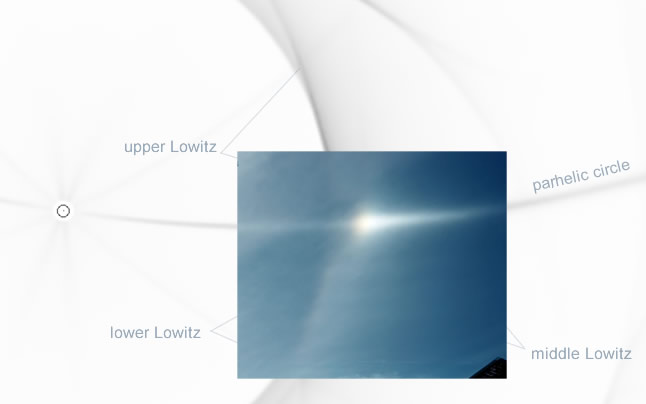 |
|||||||||||||
|
| 1988 Lowitz Pictures Robert Gorkin meticulously recorded this ice halo display at Dover, Delaware, USA on Tuesday, November 22, 1988 13:15 to 14:00 EST. At left is one of 24 images recorded on two film rolls. His images are the earliest known ones of the three Lowitz arcs. Lowitz arcs have generated more controversy than any other halo. One arc was first sketched by Tobias Lowitz in St Petersburg 1790. Subsequent sightings were sparse indeed. The absence of photographs, even from superb halo locations like the Arctic and Antarctic, led to serious doubts about their existence through to the late 1990s and in some cases beyond. That did not stop theoretical investigation. It was established that they might be formed by plate crystals with a rotation axis parallel to a large hexagonal face. In 1979 Mueller, Greenler and Mallmann used the new tool of computer ray tracing to predict that crystals with a 'Lowitz axis' passing across a crystal diagonal would produce three types of Lowitz arc, an 'upper', 'lower' and 'middle'. Gorkin's 1988 images are perhaps the earliest that show them - although the middle arc is, as always, rather elusive. In the top image (#16) the lower Lowitz arc, the only one recorded by Lowitz, stretches down from the sundog towards the 22� halo. A fainter arc extends upwards to the 22� halo, the predicted upper arc. In places the two arcs overlay the 22� halo and their presence, as here, is often best indicted by weakness of the 22� halo opposite the parhelion. There is possibly also the third predicted Lowitz arc, the middle, extending nearly vertically through the parhelion. This is slightly more evident in the stack of three images at left. Mouse over to see the matching ray tracing. When the sun is less than around 30° high the best place to search for an upper Lowitz arc is above the 22� halo rather than near the sundogs. There, it crosses the upper tangent arc and becomes tangent to the Parry arc. Gorkin's images below (#19,18 ) show it clearly. They also show the arcs near each parhelion. All images ©Robert Gorkin, shown with permission. |
A bright and vertically elongated 120º parhelion to the east. The parhelic circle stretches sunwards. |
 |
|||||||||||||
|

| About - Submit | Optics Picture of the Day | Galleries | Previous | Next | Today |
Image processing: |
Robert Gorkin's notes of the observation written at the time in his day book and partly during the same evening. The display was notable enough besides the Lowitz arcs with an upper Parry arc, supralateral arc, circumzenithal arc and possibly a helic arc - an early recording of the latter. The parhelic circle extended around the sky to a bright 120º parhelion. |
A HaloSim ray tracing for a 27º high sun overlain by three stacked images (#14-16). Mouse over to toggle the images on/off. |
 |